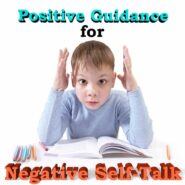Positive Guidance for Negative Self-Talk

I smiled when I received this glowing comment in my email from a Montessori guide and mom of 2:
“Language of Listening” has been without a doubt THE MOST POWERFUL approach to working with children that I have ever encountered in my 9 years as a Montessori guide (and now 4 years as a parent). I could tell you so many stories about how it’s helped me guide my very spirited 4-year old through the rough waters of adjusting to a new sibling, and it’s even helped me with my marriage! — Pilar B., thefullmontessori.com
A while before, she’d been struggling with a question that many parents and teachers face:
How do you respond to negative self-talk?
Our Q&A and the update about the child may surprise you. They are shared here with her permission; children’s names have been changed.
QUESTION:
I am working with a 7-yr old boy, Paul, who frequently engages in negative self-talk (I’m dumb, I’m stupid, I’m not good at anything, etc.) He recently transitioned to our new elementary program, where we only have 12 students (ages 6-9), and he is faced with children who are 1-2 years older than him and more advanced.
When Paul works with older children he sometimes can’t keep up with the group’s expectations. He struggles with the mechanics of writing, which wasn’t an issue in Primary but now that everyone else’s handwriting is improving, writing has become a sore spot for him. He has other issues, including getting over-stimulated in group settings, chores, playtime, etc. that we are currently addressing.
Has anyone had any experiences dealing with negative self-talk? I have tried pointing out his positive traits, acknowledging his feelings without trying to be encouraging, and even ignoring his words and just helping him to re-focus on his work. Nothing seems to work in the long run and it’s like he winds himself up with his negative mantras until he’s frothing at the mouth!
ANSWER:
You said the things you’ve tried like pointing out his positive traits, acknowledging his feeling and even ignoring his words and helping him re-focus on his work have not helped him turn himself around. Here are some thoughts and additional suggestions that have been helpful when I’ve worked with other children who compare themselves and come up short.
One thing I’ve noticed about children who need to do things “better than” others or “best” to feel good about themselves often have a hidden strength – they are master comparers. They are keen observers who have trained themselves to recognize subtle differences between things in ways that that their peers may not, including the quality of work.
When Paul compares himself and comes up short, you can start by seeing if he is correct that the other child’s work is actually better in some way. If you can’t see the difference have him point it out because he probably can.
Meet the child where he is, be authentic and validate his perspective. Don’t argue!
When starting a conversation like this it is important to be as frank as possible and use the child’s own words, unless they are truly offensive. The ability to remain unaffected as you say, “You think you are stupid, and you don’t like that,” takes the power out of “stupid” and makes it less real, whereas not saying it, makes it more real — it’s the elephant in the room concept.
Using the three-step Language of Listening approach, a response to this child at the moment of a perceived writing failure might sound like this:
Child: “I’m not good at anything! I’m stupid!”
SAY WHAT YOU SEE (SWYS): “You think you are stupid, and you don’t like that! You wanted to be able to do that like he did, and you couldn’t.”
STRENGTH: “You can see every little thing that is different. Show me the thing that bothers you the most… You saw that, and you’re right; they are different!”
SWYS: “His letter went like this, and yours went like that, and you didn’t like that. It sounds like you know how you want it to go, and you won’t be satisfied until it does!”
CAN DO: “Must be something you can do…”
Of course this conversation could go many ways depending on his responses, but no matter what, the key is remaining very matter of fact. Here’s a brief explanation of the purpose of the three steps and why they are so powerful in helping children turn themselves around:
1. SAY WHAT YOU SEE: Meets the child’s need for connection by validating his thoughts, feelings and intentions (wants/wishes). When you make the child’s case for him, he no longer has to, so resistance drops.
2. STRENGTH: Meets the child’s need for power by pointing out his strengths, reengaging him, and showing him how he is “right.”
3. CAN DO: Meets the child’s need for experience and power by turning the problem-solving over to the child
As you can see there is a little dance you do in introducing and reintroducing the different steps as needed throughout a conversation depending on the child’s response. For example, if the child were to be more wound up at the start, you would stay with the validation step of SAYing WHAT YOU SEE much, much longer until the child showed signs of self-calming. Only then can encouragement like “you won’t be satisfied until it does” and your suggestion of a CAN DO be accepted.
If you offer encouragement or a CAN DO before the child is ready, you will know because the child will return to negative self-talk. If so, you drop back to the first step, SAY WHAT YOU SEE, and stay right there with validation until the child begins to naturally move on.
The child’s words and actions tell you what to do next. That’s following the child’s lead.
In my example, when I validated the boy’s feelings, I used the neutral feeling words “You didn’t like that,” instead of naming emotions like “angry” or “frustrated” because, not seeing this child in action, I assumed that since he was critical of his own performance he would probably also be critical of his emotions. In real life, your observations of the child’s body language and facial expressions would direct your response, forward towards a CAN DO solution or back towards SAY WHAT YOU SEE validation, pointing out STRENTGHs to meet the need for power along the way.
As I said, it’s a kind of dance. Everything you do in response to the child is ultimately directed by the child’s words, actions and reactions, but the goal is always the same: to help the child meet his or her three basic needs — experience, connection and power. When they are met, children are at peace within themselves and eagerly seek new challenges.
Pointing out hidden STRENGTHS helps children change how they see themselves.
One other thing I want to mention is that in addition to pointing out positive qualities as you have been doing, when you find a hidden STRENGTH in a child like the fact that he is a master comparer, especially if it has seemed to be some kind of weakness, pointing it out with solid proof can help him identify with it and shift his or her view of self.
For example, catching this child comparing and recognizing subtle differences in non-meltdown moments and pointing it out could provide a foundation for the self-confidence he needs to work comfortably with the other children and improve his own work. It could sound like this:
STRENGTH: “You just noticed that tiny difference between those two things. You have strong comparing skills.”
If you’d like to learn more about the Language of Listening, you can read my little book SAY WHAT YOU SEE for Parents and Teachers. I hope you find it helpful.
Hidden STRENGTHS to the rescue!
UPDATE FROM THE GUIDE:
The situation with the Paul took a while to resolve, as those very deeply entrenched emotional issues often do. But one BEAUTIFUL outcome of using the approach as you suggested it (i.e. turning his awareness of other people’s abilities into a strength, rather than a liability) was that he started to use his keen observation skills to identify strengths in his work mates and help assign responsibilities during group work. Here’s what happened:
Three children (two 8-year-olds, Aaron and Bella, and 7-year-old Paul) decided to do a project on the Titanic (a particularly fascinating subject for Paul, who knew EVERYTHING about the disaster). I wanted to see how well they could work together without directing the process, so I just observed them as they started.
They each decided they were going to write a piece of the report and successfully divided the topics among themselves. The two 8-year-olds got to work right away, researching and writing with ease. But Paul, who as you might recall struggled mightily to write (even though he read way above his grade level and was very eloquent), painfully scratched out a few words on his paper. He kept looking at his friends’ work and was growing more and more frustrated. Then, he lashed out in frustration, said the work was stupid, and that he wasn’t interested in doing the project anymore. The other two were dumbfounded, since he LOVED the topic, and that’s when I stepped in.
I don’t remember my exact words, but it was something like: “You seem really frustrated! You know so much about this topic, and I imagine your thoughts are coming to you faster than you can write them down. What do you think can be done to help you share all your knowledge?”
The result wasn’t immediate, he fumed and didn’t seem to want to find a solution. But, as is the case with children, his two workmates stepped in and took over. They lifted him up and encouraged him not to leave the project because he was the one who knew the most. Paul brooded for a few minutes, and then his face lit up. He turned to his friends and said (I will never forget this moment), “We’re doing this all wrong! Aaron, you are like the printing press, because you write really quickly. Bella, you are like the paintbrush, because you’re such a great artist. And I’m like the encyclopedia because I know so much about the Titanic. Why don’t I talk, Aaron writes, and Bella does the drawings?”
My jaw Hit. The. Floor. It was such a powerful moment and a beautiful lesson. It made a very difficult year of teaching so worthwhile. 🙂
SUMMARY
Such a rewarding moment for the guide and the children! Everything she’d been doing all year came together, and Paul was able to use that moment to burst through his comparative mindset (better/worse) into a world of equal differences because of the keen observation skills he mastered by comparing! She said what she saw, stepped into his perspective (thoughts coming faster than he could write), and turned it over to him and the others to solve. And he came up with the most positive solution imaginable! That’s what’s possible when you follow the child’s lead and provide guidance from there.





